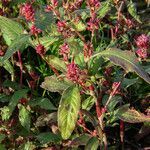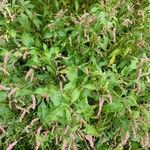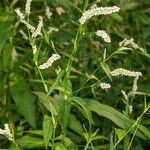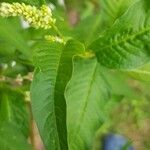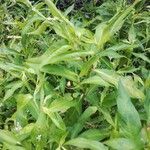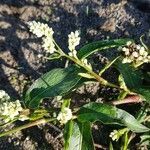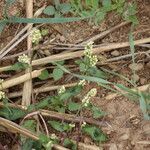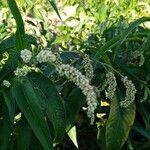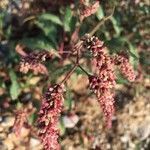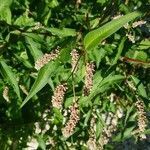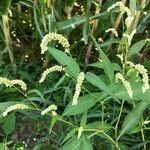Robust, erect, annual herb, hydrophyte or helophyte, up to 0.1-3.0 m high; stems cylindrical, reddish, swollen at nodes. Ocreae tubular, membranous, up to 30 mm long, brown, conspicuously veined. Leaves shortly petiolate, lanceolate, base cuneate, apex acute; lower surface glandular-punctate with midvein and margins coarsely white-strigose. Inflorescence a terminal thyrse, total length up to 105 mm, 4 or 5 from upper ocreae. Bracts ovate, ciliate or not. Perianth 4-or 5-lobed, red, pink, greenish or white. Stamens 6, exserted. Ovary 2-angular; styles 2, exserted. Flowering time Sept.-May. Fruit a lenticular nut with dimpled faces, dark brown, shiny.
An erect herb. It can grow for one year or for several years. It can lie along the ground or be erect. It grows to 1 m high. The stems are slender. They can be 2.4 cm across. The leaves are sword shaped and 12 cm long. They can be 25 cm long by 5 cm wide but are mostly smaller. There can be hairs along the larger veins on the upper surface of the leaf. The base is narrowly wedge shaped and they taper to the tip. The flower arrangement is at the top. The false spikes are like cylinders. They are dense. The fruit are flattened and flask shaped. It has flat faces with round edges. They are 2 mm long. They are black or brown and shiny.
Annual herb, up to 1 m high. Leaves with blade ovate to narrowly ovate, base narrowing into petiole, apex acuminate; upper surface glabrous, petioles and main vein on lower surface yellow strigose-hairy. Ocrea without a spreading herbaceous limb; glabrous; with or without terminal cilia. Flowers: in a spike-like raceme; perianth red, pink, white or greenish; Sep.-May. Fruit with nut biconvex, smooth.
Annual herb, up to 1 m high. Ocreae glabrous. Petiole and main vein on undersurface yellow strigose-hairy. Peduncles with stalked glands. Flowers red, pink, white or greenish.
